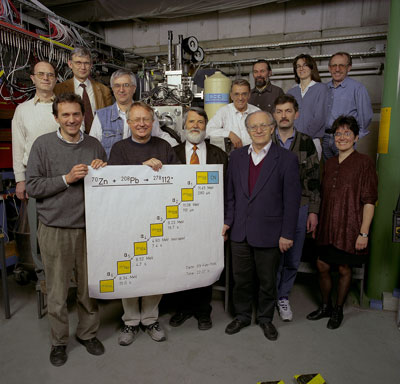| Posted: July 14, 2010 |
Chemical element 112 is named Copernicium |
|
(Nanowerk News) On Monday July 12, 2010, the chemical element discovered at GSI was christened "copernicium". This symbolic christening celebrated the element's eternal entry into the periodic table of elements. Copernicium is 277 times heavier than hydrogen and the heaviest element officially recognized in the periodic table. Its name honors the great astronomer Nicolaus Copernicus (1473-1543).
|
|
Element 112 was discovered by an international team of scientists headed by professor Sigurd Hofmann at GSI. The new element has officially carried the name copernicium and the symbol "Cn" since February 19, 2010. Naming the element after scientist Nicolaus Copernicus follows the longstanding tradition of choosing an accomplished scientist as eponym. Copernicus' work in astronomy is the basis of our modern world view, which states that the Sun is the center of our solar system with the Earth and all the other planets circling around it.
|
 |
| The international team of scientists presents the production of element 112 for the first time.
|
|
On February 9, 1996, Sigurd Hofmann and his team produced an atom of the element copernicium for the first time. Using the 100 meter long GSI accelerator, they fired charged zinc atoms, i.e. zinc ions, onto a lead foil. The fusion of the atomic nuclei of the two elements produced an atom of the new element 112. This atom was only stable for a fraction of a second; the scientists were able to identify the new element by measuring the radiation emitted during its decay.
|
|
Further independent experiments at other research facilities confirmed the discovery of the element. Last year, IUPAC officially recognized the existence of element 112, acknowledged the GSI team's discovery and invited them to propose a name.
|
|
Copernicium is the sixth chemical element that GSI scientists discovered and named. The other elements carry the names bohrium (element 107), hassium (element 108), meitnerium (element 109), darmstadtium (element 110), and roentgenium (element 111).
|
|
21 scientists from Germany, Finland, Russia, and Slovakia collaborated in the GSI experiments that led to the discovery of element 112.
|
|
The goal of GSI scientists is to determine the heaviest element in the world and identify the limit of the periodic table of elements, in order to enhance their knowledge about the structure of matter and to learn about the genesis of life.
|
|
GSI Helmholtzzentrum für Schwerionenforschung
|
|
GSI is a research centre with more than 1000 employees, financed by the German federation and the German state of Hesse with a budget of some 100 million euros. GSI operates a one-of-a-kind accelerator facility for ion beams, i.e. beams of charged atoms. Every year, more than 1200 guest scientists from all over the world use the accelerator facility for fundamental research. GSI's research program comprises a broad range of fields from nuclear and atomic physics to plasma and materials research as well as biophysics and medicine.
|
|
GSI's most famous advancements are the discovery of new chemical elements and the development of a novel cancer therapy using ion beams, which recently started routine operation at clinics. Over the coming years, the new accelerator facility FAIR (Facility for Antiproton and Ion Research) will be built at GSI with an investment of 1.2 billion euros (with international partners bearing 25% of the costs).
|

